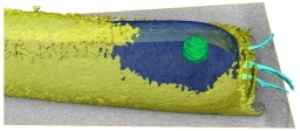UCLA professor, Robert Gunsalus, has observed that Methanosprillum hungatei, a specific type of Archaea, consists of highly efficient energy-storage structures. He made this observation using advanced imaging devices at UCLA’s California NanoSystems Institute (CNSI).
Gunsalus has studied anaerobic organisms for several years including M. hungatei, which survives in oxygen-depleted surroundings associated with only limited amounts of energy.
 3-D model of M. hungatei, with granule (green)
3-D model of M. hungatei, with granule (green)
A professor of microbiology, immunology and molecular genetics, Hong Zhou, and Gunsalus worked together to carry out a comprehensive study of the sub-cellular formations in M. hungatei. The imaging activities were done by Dan Toso, a graduate student in Zhou's lab, utilizing devices from the Electron Imaging Center for Nanomachines (EICN). The team developed comprehensive images of the M. hungatei interior and were amazed at the presence of granular structures that measured roughly 150 nm in diameter and were used for energy storage.
The team succeeded in determining the granule density with the help of a Titan scanning transmission electron tomography (STEM) microscope, energy-dispersive X-ray spectroscopy, and cryo-electron microscopy, which is present in the tool set at EICN lab.
The minute granules, measuring less than 0.5 % of the cell, are capable of storing 100-times more energy than other cells. Each M. hungatei forms two granules. As all M. hungatei create granules in the same place and at the same stage in their life-cycle, it is possible that their DNA carries certain genetic directions for granule positioning and formation.
If the genetic instructions involved in the creation of granules can be determined in the genome, it will enable them to utilize the granules as a chemical battery for synthetic cells. The researchers hope to determine the biological properties of the sheaths and granules in M. hungatei.